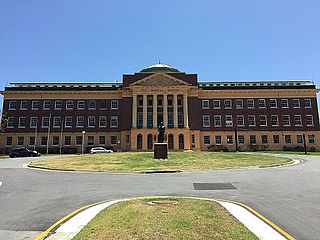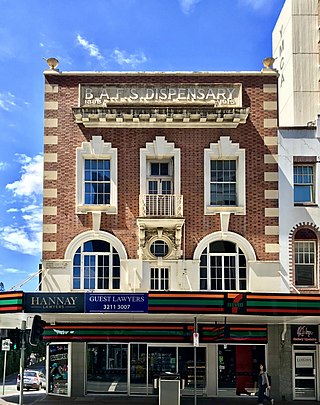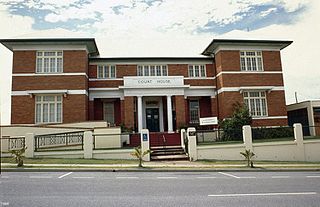
McWhirters is a heritage-listed former department store at Wickham Street, Fortitude Valley, City of Brisbane, Queensland, Australia. It is also known as McWhirters Marketplace, McWhirters & Son Ltd, and Myer. It was added to the Queensland Heritage Register on 21 October 1992.

All Saints Anglican Church is a heritage-listed church at 32 Wickham Terrace, Spring Hill, City of Brisbane, Queensland, Australia. First founded in 1862, the current building designed by Benjamin Backhouse was completed in 1869, making it the oldest Anglican church in Brisbane. For most of its history, it has been identified with the High Church or Anglo-Catholic tradition within Anglicanism. It was added to the Queensland Heritage Register on 21 October 1992.

Lady Bowen Hospital is a heritage-listed former maternity hospital and now social housing and office complex at 497–535 Wickham Terrace, Spring Hill, City of Brisbane, Queensland, Australia. It was designed by John H. Buckeridge and built from 1889 to 1890 by John Quinn. It was also known as Brisbane Lying-In Hospital and the Lady Bowen Hostel. It was added to the Queensland Heritage Register on 23 April 1999. The complex consists of the former hospital and nurses' quarters buildings; a third building which had been contained in the heritage listing was demolished c. 2005–2008.

Baptist City Tabernacle is a heritage-listed church at 163 Wickham Terrace, Spring Hill, Brisbane, Queensland, Australia. It was designed by Richard Gailey and built from c. 1889 to 1890. It was added to the Queensland Heritage Register on 21 October 1992.

University of Queensland Mayne Medical School is a heritage-listed university building at 288 Herston Road, Herston, City of Brisbane, Queensland, Australia. It was designed by Raymond Clare Nowland and built from 1938 to 1939. It is also known as University of Queensland Medical School. It was added to the Queensland Heritage Register on 24 June 1999.

Old Bishopsbourne is a heritage-listed house at 233 Milton Road, Milton, City of Brisbane, Queensland, Australia. It was designed by Benjamin Backhouse and built from 1865 to 1959. It is also known as St Francis Theological College and Bishopsbourne. It was added to the Queensland Heritage Register on 21 October 1992.

Craigston is a heritage-listed apartment block at 217 Wickham Terrace, Spring Hill, City of Brisbane, Queensland, Australia. It was designed by Atkinson & Conrad and built in 1927. It was added to the Queensland Heritage Register on 21 October 1992.

Fortitude Valley Police Station is a heritage-listed police station at 119 Brookes Street, Fortitude Valley, City of Brisbane, Queensland, Australia. It was designed by Raymond Clare Nowland and built from 1935 to 1936. It was added to the Queensland Heritage Register on 24 June 1999.

Empire Hotel is a heritage-listed hotel at 339 Brunswick Street, Fortitude Valley, City of Brisbane, Queensland, Australia. It was designed by Richard Gailey and built in 1888 by Smith and Ball. It was renovated in 1925 to a design by Richard Gailey, Junior. It was further renovated in 1937 to incorporate apartments designed by Hall and Phillips. It was added to the Queensland Heritage Register on 21 October 1992.

Oogarding is a heritage-listed villa at 100 Simpsons Road, Bardon, City of Brisbane, Queensland, Australia. It was designed by architect Mervyn Rylance and built in 1940 by Jan Cupka. It was extended in 1964 and 1965. It was added to the Queensland Heritage Register on 23 June 2000.

Santa Barbara is a heritage-listed villa at 209 Moray Street, New Farm, City of Brisbane, Queensland, Australia. It was designed by Eric Percival Trewern and built from 1929 to 1930 by DF Roberts. It was added to the Queensland Heritage Register on 28 January 2000.

United Service Club Premises is a heritage-listed club house at 183 Wickham Terrace, Spring Hill, City of Brisbane, Queensland, Australia. It was designed by architect Claude William Chambers and built from 1906 to 1947. It is also known as Montpelier and The Green House. It was added to the Queensland Heritage Register on 28 April 2000.

Inchcolm is a heritage-listed former office building at 73 Wickham Terrace, Spring Hill, City of Brisbane, Queensland, Australia. It was designed by Eric P Trewern and built in 1930 by J I Green & Son. It was converted into a hotel in 1998, and renovated in 2014. It now trades as Ovolo Inchcolm under the Ovolo Hotels Group. It was added to the Queensland Heritage Register on 23 March 1998.

Ballow Chambers is a heritage-listed office building at 121 Wickham Terrace, Spring Hill, City of Brisbane, Queensland, Australia. It was designed by Lange Leopold Powell and built from 1924 to 1926 by John Hutchinson. It was added to the Queensland Heritage Register on 21 October 1992.

Wickham House is a heritage-listed office building at 155–157 Wickham Terrace, Spring Hill, City of Brisbane, Queensland, Australia. It was designed by Francis Richard Hall and built from 1923 to 1924 by F J Corbett. It was added to the Queensland Heritage Register on 23 June 2000.

St Andrews War Memorial Hospital Administration Building is a heritage-listed former house and residential college and now hospital administration building at 465 Wickham Terrace, Spring Hill, City of Brisbane, Queensland, Australia. It was built from 1860s to 1936. It was also known as Emmanuel College. It was added to the Queensland Heritage Register on 24 March 2000.

BAFS Building is a heritage-listed former pharmacy at 331 & 333 George Street, Brisbane City, City of Brisbane, Queensland, Australia. It was designed by Lange Leopold Powell and built from 1915 to 1916 by B Cunningham. It was added to the Queensland Heritage Register on 22 February 2002.

Brisbane Dental Hospital and College is a heritage-listed former dental hospital at 168 Turbot Street, Brisbane City, Queensland, Australia. It was designed by Raymond C Nowland and built from 1938 to 1941 by the Queensland Department of Public Works. It was added to the Queensland Heritage Register on 23 April 1999.

Gladstone Court House is a heritage-listed courthouse at 16 Yarroon Street, Gladstone, Gladstone Region, Queensland, Australia. It was designed by Raymond C Nowland and built from 1940 to 1942. It was added to the Queensland Heritage Register on 29 May 1998.

Brisbane Boys' College Buildings are the heritage-listed private school buildings at Brisbane Boys' College, 55 Moggill Road, Toowong, City of Brisbane, Queensland, Australia. They were built from 1930 to 1950. They were added to the Queensland Heritage Register on 21 October 1992.























